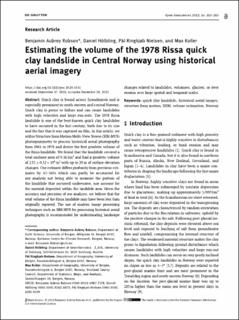| dc.contributor.author | Robson, Benjamin Aubrey | |
| dc.contributor.author | Hölbling, Daniel | |
| dc.contributor.author | Nielsen, Pål Ringkjøb | |
| dc.contributor.author | Koller, Max | |
| dc.date.accessioned | 2022-05-27T12:10:27Z | |
| dc.date.available | 2022-05-27T12:10:27Z | |
| dc.date.created | 2022-03-25T09:31:12Z | |
| dc.date.issued | 2022 | |
| dc.identifier.issn | 2391-5447 | |
| dc.identifier.uri | https://hdl.handle.net/11250/2996473 | |
| dc.description.abstract | Quick clay is found across Scandinavia and is especially prominent in south-eastern and central Norway. Quick clay is prone to failure and can cause landslides with high velocities and large run-outs. The 1978 Rissa landslide is one of the best-known quick clay landslides to have occurred in the last century, both due to its size and the fact that it was captured on film. In this article, we utilise Structure from Motion Multi-View Stereo (SfM-MVS) photogrammetry to process historical aerial photography from 1964 to 1978 and derive the first geodetic volume of the Rissa landslide. We found that the landslide covered a total onshore area of 0.36 km2 and had a geodetic volume of 2.53 ± 0.52 × 106 m3 with up to 20 m of surface elevation changes. Our estimate differs profusely from previous estimates by 43–56% which can partly be accounted for our analysis not being able to measure the portion of the landslide that occurred underwater, nor account for the material deposited within the landslide area. Given the accuracy and precision of our analyses, we believe that the total volume of the Rissa landslide may have been less than originally reported. The use of modern image processing techniques such as SfM-MVS for processing historical aerial photography is recommended for understanding landscape changes related to landslides, volcanoes, glaciers, or river erosion over large spatial and temporal scales. | en_US |
| dc.language.iso | eng | en_US |
| dc.publisher | De Gruyter | en_US |
| dc.rights | Navngivelse 4.0 Internasjonal | * |
| dc.rights.uri | http://creativecommons.org/licenses/by/4.0/deed.no | * |
| dc.title | Estimating the volume of the 1978 Rissa quick clay landslide in Central Norway using historical aerial imagery | en_US |
| dc.type | Journal article | en_US |
| dc.type | Peer reviewed | en_US |
| dc.description.version | publishedVersion | en_US |
| dc.rights.holder | Copyright 2022 the authors | en_US |
| cristin.ispublished | true | |
| cristin.fulltext | original | |
| cristin.qualitycode | 1 | |
| dc.identifier.doi | 10.1515/geo-2020-0331 | |
| dc.identifier.cristin | 2012453 | |
| dc.source.journal | Open Geosciences | en_US |
| dc.source.pagenumber | 252-263 | en_US |
| dc.identifier.citation | Open Geosciences. 2022, 14 (1), 252-263. | en_US |
| dc.source.volume | 14 | en_US |
| dc.source.issue | 1 | en_US |

